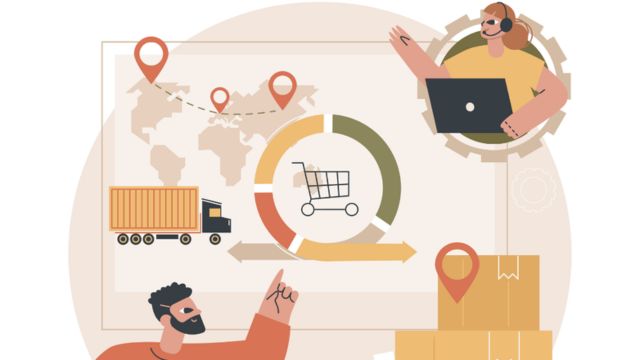Supply chains have become ever more complex in the complicated global market of today, encompassing several nations, vendors, and modes of transportation. Transparency of supply chains has become increasingly important for companies and customers alike as consumer expectations grow and regulatory criteria get tougher. But what does supply chain openness truly entail, and why is it so beneficial for everyone involved?
Understanding Supply Chain Transparency
Supply chain transparency refers to the openness and visibility a firm provides at every stage of its product journey—from raw material procurement to manufacture, shipping, and delivery to the end consumer. This transparency can encompass revealing information such as supplier identities, production circumstances, environmental impact, and product origin.
With innovations in technology such as blockchain, IoT (Internet of Things), and cloud-based tracking systems, firms can now give extensive, real-time data about their supply chains more simply than ever before.
Benefits for Consumers
1. Building Consumer Trust and Loyalty
Consumers today are more informed and conscious about the products they buy. They want to know if products are ethically sourced, environmentally friendly, and safe. When companies openly share their supply chain details, it builds trust and fosters a stronger emotional connection between the brand and the consumer, encouraging repeat purchases and brand loyalty.
2. Empowering Ethical and Sustainable Choices
Many consumers prioritize sustainability and social responsibility. Transparency enables them to verify claims related to fair labor practices, eco-friendly materials, and reduced carbon footprints. This empowers buyers to make purchasing decisions that align with their personal values.
3. Assurance of Product Quality and Safety
With full visibility into production and sourcing processes, consumers gain assurance that the products meet high standards of quality and safety. This is especially critical in sectors such as food, pharmaceuticals, and medical supplies, where product integrity can have significant health implications.
4. Enhanced Customer Experience Through Real-Time Updates
Transparent supply chains allow customers to track their orders in real-time, providing accurate information about shipment status, expected delivery times, and potential delays. This reduces frustration, increases satisfaction, and helps consumers plan accordingly.
Benefits for Businesses

1. Strengthening Brand Reputation and Competitive Edge
Transparency signals accountability and responsibility. Brands that adopt transparent practices are seen as trustworthy and ethical, differentiating themselves in crowded marketplaces. This reputational advantage can attract socially conscious consumers and open new market opportunities.
2. Proactive Risk Management and Crisis Response
Visibility across the supply chain helps businesses identify vulnerabilities—such as supplier reliability issues, geopolitical risks, or logistical bottlenecks—before they escalate into full-blown crises. Early detection allows companies to take corrective actions, mitigate risks, and maintain continuity.
3. Increased Operational Efficiency and Cost Savings
Detailed insights into each step of the supply chain help identify inefficiencies, redundancies, and waste. Businesses can optimize inventory management, improve supplier collaboration, and streamline logistics, ultimately reducing costs and boosting profitability.
4. Easier Compliance With Regulatory Standards
Many industries face strict regulations regarding product safety, labor conditions, and environmental impact. Transparent supply chains provide comprehensive documentation and traceability, simplifying compliance audits and reducing the risk of fines or legal actions.
5. Facilitating Innovation and Continuous Improvement
By closely monitoring supply chain processes, businesses can gather data to innovate better products, improve sustainability, and enhance overall performance. Transparency encourages accountability and drives a culture of continuous improvement.
Real-World Examples of Supply Chain Transparency
-
Patagonia (Apparel Industry): Known for its commitment to environmental responsibility, Patagonia provides customers with detailed information about the sourcing of its raw materials and the conditions in its factories, helping build strong brand loyalty.
-
Walmart (Retail Sector): Walmart leverages blockchain technology to track produce and meat products from farms to shelves, improving food safety and reducing the impact of recalls.
-
Johnson & Johnson (Healthcare): The company maintains rigorous transparency in its medical supply chains to ensure safety and regulatory compliance, especially critical in times of health emergencies.
Challenges and Considerations
While supply chain transparency offers various benefits, implementing it is not without hurdles. Companies may confront difficulties like supplier reluctance, data privacy concerns, and the cost of incorporating advanced tracking systems. Still, the long-term benefits usually exceed these challenges.
Conclusion
Transparency in supply chains is not optional anymore; rather, it is necessary to establish confidence, raise standards, and get a competitive edge. For customers, it provides the assurance that their goods are delivered on time, safe, and ethically acquired. For companies, it offers vital information that improves performance, controls risk, and builds brand reputation.
In a world where consumers want greater responsibility and knowledge, firms that embrace supply chain transparency are better positioned to grow, innovate, and generate enduring value.
Looking for reliable, high-quality industrial and medical supplies? At Jand J Supplies, we offer a wide range of products designed to meet your business needs efficiently. Contact us today to get the best deals and exceptional service tailored just for you!








